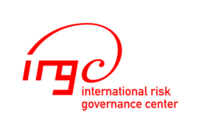 | |
| Founded | Geneva, Switzerland (2003) |
|---|---|
| Type | Nonprofit organization |
| Focus | Risk governance Risk management Regulations |
| Headquarters | École polytechnique fédérale de Lausanne Lausanne, Switzerland |
Area served | Worldwide |
| Website | www |
The International Risk Governance Center (IRGC) is an independent non-profit organisation, based at École Polytechnique Fédérale de Lausanne (EPFL) in Lausanne, Switzerland. It is an interdisciplinary organisation that works to improve the understanding, management and governance of emerging systemic risks that may have significant adverse consequences for human health and the environment, the economy and society.[1]
IRGC develops risk governance strategies, that focus on involving all key stakeholder groups, including citizens, governments, businesses and academia.
History
IRGC was established by the Swiss Federal Assembly as an independent and international body to bridge increasing gaps between science, technological development, decision-makers and the public.[2] IRGC was formally founded in Geneva as a private foundation in June 2003. [3]
In June 2012, IRGC moved its offices from Geneva to the École Polytechnique Fédérale de Lausanne (EPFL) in Lausanne, Switzerland. IRGC signed a formal collaboration agreement with EPFL that came into effect on January 1, 2013, according to which EPFL will support IRGC’s mission and activities.[4]
In July 2012, IRGC was granted special consultative status with the United Nations Economic and Social Council (ECOSOC)[5] and in July 2014, became a member of the Sustainable Development Solutions Network (SDSN).[6]
Activities
IRGC's work is rooted in the IRGC Risk Governance Framework,[7] as well as subsequent frameworks that were developed to apply more specifically to the governance of emerging and systemic risks. It applies these frameworks to a wide range of specific risk domains, focused increasingly on risks associated with emerging technologies.
The IRGC Risk Governance Framework provides guidance for early identification and handling of risks involving multiple stakeholders. It recommends an inclusive approach to frame, assess, evaluate, manage and communicate important risk issues, often marked by complexity, uncertainty and ambiguity. The Framework is generic and adaptable, and can be tailored to various risks and organisations. The Framework comprises four interlinked elements, with three cross-cutting aspects.
The Framework has been used and discussed in many institutions and organisations, including the European Food Safety Authority,[8] the Health Council of the Netherlands,[9] the UK Treasury,[10] the US Environmental Protection Agency,[11] and other private and public organisations.
IRGC has also produced Guidelines for Emerging Risk Governance,[12] Guidelines for the Governance of Systemic Risks,[13] resource guides on resilience,[14] and the guide Involving Stakeholders in the Risk Governance Process.[15]
Areas of focus
IRGC's activities focus on emerging risk issues, slow-developing catastrophic risks, risk governance deficits, and the fostering of risk governance cultures worldwide.
IRGC is active in the areas of nanotechnology, unconventional gas development, carbon capture and storage, solar radiation management, digitalization, energy transition, deepfakes and space debris. Previously, it has done work on critical infrastructures and bio-energy.[16]
IRGC is involved in two EU Horizon 2020 projects: TRIGGER,[17] which focuses on risk governance for digital technology, and NANORIGO,[18] which aims to develop and implement a transparent, transdisciplinary Nanotechnology Risk Governance Framework and a related Risk Governance Council.
See also
- Risk analysis
- Risk governance
- Risk management
External links
References
- ^ Mission and Purpose IRGC. Retrieved 10 April 2015
- ^ Botschaft über die Förderung von Bildung, Forschung und Technologie in den Jahren 2004–2007. Federal Gazette (2003). Retrieved 06 August 2014.
- ^ Eidgenössisches Departement des Innern Archived 2016-03-12 at the Wayback Machine. Retrieved 06 August 2014
- ^ History IRGC. Retrieved 10 April 2015
- ^ List of non-governmental organizations in consultative status with the Economic and Social Council as of 1 September 2013. United Nations Economic and Social Council. Retrieved 06 August 2014.
- ^ SDSN Welcomes New Members. Sustainable Development Solutions Network. Retrieved 06 August 2014.
- ^ "Risk Governance Framework". International Risk Governance Center. IRGC. Retrieved 25 January 2021.
- ^ Dreyer, M. and Renn, O. (eds) (2009) Food Safety Governance: Integrating Science, Precaution and Public Involvement (Heidelberg and New York, Springer)
- ^ Health Council of the Netherlands (2006) Health Significance of Nanotechnologies, (The Hague: Health Council of the Netherlands: publication no. 2006/06E
- ^ UK Treasury Department (2005) “Managing Risks to the Public: Appraisal Guidance”, Draft for Consultation, HM Treasury Press, London
- ^ US EPA (2009) Potential Nano-enabled Environmental Applications for Radionuclides. EPA-402-R-06-002, Washington: EPA.
- ^ "Emerging Risks". International Risk Governance Center. IRGC. Retrieved 25 January 2021.
- ^ "Systemic Risks". International Risk Governance Center. IRGC. Retrieved 25 January 2021.
- ^ "Resilience". International Risk Governance Center. IRGC. Retrieved 25 January 2021.
- ^ "Focus on Stakeholder Involvement". International Risk Governance Center. IRGC. Retrieved 25 January 2021.
- ^ http://www.irgc.org/issues/ Issues. IRGC. Retrieved 25 April 2015.
- ^ "TRIGGER". TRIGGER. TRIGGER. Retrieved 25 January 2021.
- ^ "NANORIGO". NANORIGO. NANORIGO. Retrieved 25 January 2021.